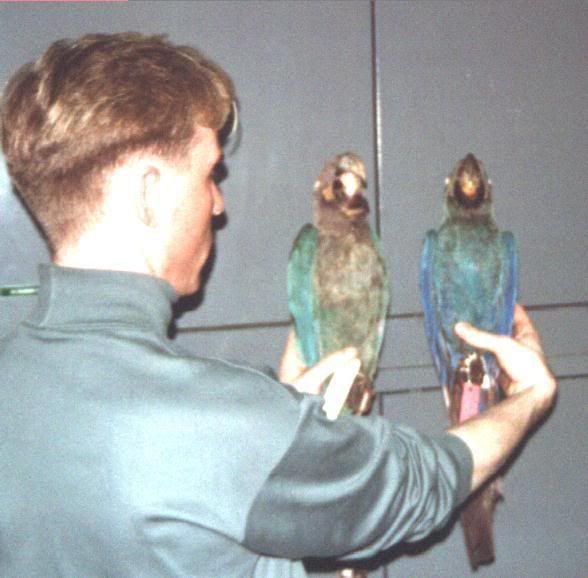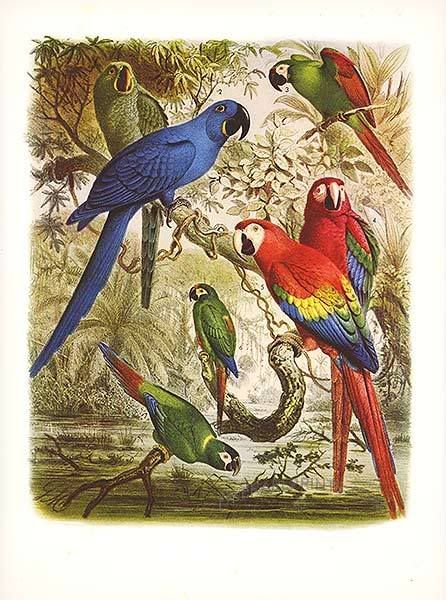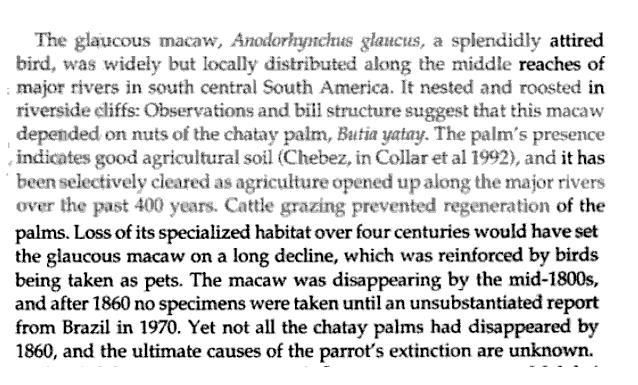|
|
Post by another specialist on Dec 9, 2006 22:32:19 GMT
Schouten has done other works which are not in the book
|
|
|
|
Post by sebbe67 on Dec 10, 2006 18:16:05 GMT
Schouten has done other works which are not in the book Yes, as Frank say the painter has painted a serie of extinct animals, not all of them are illustrated in the book A Gap in nature but they are still treated as a part of that serie. |
|
|
|
Post by Carlos on Dec 10, 2006 19:54:03 GMT
And where can they be seen?
|
|
|
|
Post by another specialist on Dec 10, 2006 20:04:03 GMT
|
|
|
|
Post by sebbe67 on Dec 10, 2006 20:04:16 GMT
|
|
|
|
Post by another specialist on Dec 10, 2006 20:17:50 GMT
thanks for link sebbe67
|
|
|
|
Post by RSN on Dec 10, 2006 21:18:49 GMT
Thanks for the explanation! Excellent sites!
|
|
|
|
Post by Carlos on Dec 10, 2006 21:19:28 GMT
Won-der-ful link, Thanks!!!!
|
|
|
|
Post by another specialist on Dec 12, 2006 20:48:18 GMT
Glaucous Macaw Anodorhynchus glaucus Critically Endangered. Old records of this species cover a wide area of northern Argentina, southern Paraguay, north-east Uruguay and Brazil, from Paraná state southwards, but are mostly clustered along the middle reaches of the major rivers (the Uruguay, Paraná and Paraguay) and adjacent areas, especially in Corrientes province, Argentina. It was rare even before the mid 19th century and there were only two reasonably convincing reports in the 20th century, one a direct observation in Uruguay in 1951, and another based on local reports in Paraná in the early 1960s15. A recent, thorough survey of Corrientes (Argentina) and Rio Grande do Sul (Brazil) found no evidence of its presence and concluded that it had become extinct in the first half of the 20th century. Whilst it has been generally treated as extinct, persistent rumours of recent sightings, local reports and birds in trade indicate that a few birds may survive. Anyone with an urge to track down the Glaucous Macaw is best advised to seek out suitable—and ideally remote— savanna habitats with fruiting palms (on which the species fed) and nearby cliffs (where it roosted and nested). The main food plant was probably the Yatay Palm Butia yatay, so any regions where this is a dominant feature should be identified, perhaps through remote sensing techniques, and surveyed. As with Spix’s Macaw, any sightings of this species should be reported with extreme discretion, involving in the first instance a strictly confidential communication to BirdLife International. www.neomorphus.com/work/JPDF/lostandfound.pdf |
|
|
|
Post by RSN on Apr 22, 2007 1:16:48 GMT
 2. Anodorhynchus glaucus 3. Anodorhynchus leari J.M.Forshaw & W.T.Cooper (1977). Parrots of the World. T.F.H. Pub., Inc. Neptune, N.J., USA. p. 355 |
|
|
|
Post by RSN on Apr 28, 2007 22:56:46 GMT
It is confusing me... it had the head with these grey patches like that is show in the stuffed specimens or it is almost entire blue with green reflections like the pic in BirdLife or in that of the same painter in Gapi in Nature?
|
|
|
|
Post by another specialist on May 24, 2008 17:47:12 GMT
|
|
|
|
Post by another specialist on Nov 4, 2008 9:00:24 GMT
Tuesday, 15th August 2006  I have just returned from attending this year's American Federation of Aviculture (AFA) convention in Dallas. There were a number of very interesting and informative presentations as well as excellent opportunity to network. While there I managed to visit the Dallas Zoo and the Dallas World Aquarium. The latter was particularly interesting, indeed amazing, because it is constructed within an old warehouse in the heart of downtown Dallas. I was shown round by the senior aviculturist, Josef Lindholm III, who gave two presentations at the convention on aracaris and cotingas. He had met some of the leading aviculturists of the past, including shortly before his death in 1985, Jean Delacours, who apparently in his early teens saw a Glaucous Macaw (Anodorhynchus glaucus) at the Jardin d'Acclimatation in Paris just over 100 years ago in the opening years of the 20th century. According to Josef he commented "It was quite ugly! - Too large a head, too short a tail, an unattractive colour... Not pretty at all... But it was the only one I saw in the world!" When I visited the museum at the Jardin D'Acclimatation towards the end of the 1980s I took a photo of the Glaucous Macaw specimen there being held alongside that of a Lear's Macaw. While on the subject of the Glaucous Macaw, Carlos Bianchi, who works closely with IBAMA, the Brazilian government wildlife agency, on both the Lear's Macaw and Spix's Macaw programmes, mentioned in his presentation on the status and conservation of parrots in Brazil that this species had been declared extinct in the Brazilian Red List to be published later this year although the IUCN in their publication last year (2005) persisted in giving it a status of critical. The reason for this appears to be a number of unconfirmed reports of sightings as well as a comment by Fernando Costa Straube in his work on avifauna in the southeast region of the state of Parana [Contribuições ao conhecimento da avifauna da região sudoeste do estado do Paraná (Brasil)] published in 1988. He says that he was informed by local inhabitants that between 1961 and 1964 there were two species of macaw living along the margins of the river Iguaçu. One was red with blue wings, which he took to be the Green-winged Macaw (Ara chloroptera) and the other was more seldom, smaller, greenish-blue with yellow at the base of its bill. He then puts in brackets the name Anodorhynchus glaucus with a question mark. This question mark has apparently been converted to recorded sightings by the experts at the IUCN. However, I do not believe these reports justify a belief in the species' continued existence. Two more expeditions have been mounted recently and have found no trace of the species. Reports such as that above are notoriously unreliable. I can remember being told by a rancher in the northern Pantanal eleven years ago that he had seen a small blue macaw in the area. When I showed him illustrations of the four blue macaws he pointed at the Spix's Macaw and insisted that was the bird. "Sky blue" he kept repeating. At the time we thought there was a remote possibility it might have been an escapee from a trafficker on his way to Paraguay - some eight years earlier three Spix's Macaws had been confiscated from a house in Asuncion. However, we soon came to the view that the rancher was just simply mistaken. www.bluemacaws.org/new.htm |
|
|
|
Post by another specialist on Nov 4, 2008 9:05:35 GMT
Sunday, 3rd April 2005  I have just returned from Washington to see the latest addition to the family. My eldest son, a marine biologist, moved there last November with his family to work for NOAA. I took the Jack Russell terriers out for a walk after the long flight and heard the cuckoo in the woods. In previous years I have heard it first in early May and last year at the end of May, so this year it appears to be very early. The weather has been very strange recently. Only a couple of weeks ago we had snow and freezing temperatures. Today it was 15 C (59 F) and the hedgerows are full of singing birds. In Washington I experienced very heavy rain and thunder storms before my departure. Although my trip was for two days only I did manage a brief visit to the specimen collection at the Smithsonian Institution. There I examined the three Glaucous Macaws (Anodorhynchus glaucus) collected by Cptn. Thomas Page during his expedition to Argentina and Paraguay from 1853 to 1856. When researching this now extinct macaw in 1992 I had not been able to find any reference to the Glaucous Macaw in his narrative of the expedition published in 1859 except in the list of perching birds in Appendix J, where it appears as Anodorhynchus cinereus. See footnote in my article in the Parrot Society magazine published in 1992 The date given for the collection of the macaws on the tags attached to the three specimens was 1st August 1854. On examining the text again today I discovered Page was exploring the Riachuelo river, a tributary of the Paraná just south of the Argentine city of Corrientes, at that time and indeed writes "I was fortunate in obtaining some rare birds........". The specimen marked A.cinereus also gives the location as Corrientes. It is easy to understand why Page described the macaws as "cinereus" The three specimens at the Smithsonian look very grey on the breast area in certain light - see image by clicking here. www.bluemacaws.org/new.htm |
|
|
|
Post by another specialist on Nov 4, 2008 9:13:08 GMT
 Genuine antique print of Macaws (Glaucous, Hyacinthine, Sever, from Parrots by Reichenow. Information Dr Anton Reichenow (1847 - 1941) was a German ornithologist. Reichenow worked at the Humboldt Museum from 1874 to 1921. He was an expert on African birds, making a collecting expedition to West Africa in 1872 and 1873. He was editor of the Journal für Ornithologie from 1894 to 1921. These prints are from a work by Reichenow and were drawn by Gustav Mützel (1839-1893), the famous wild life artist. The parrots are organized on the prints by family, and illustrate all the species then known from Australia, New Guinea, Asia, Philippines, Africa and America. Date This print is from a limited edition facsimile of Reichenow' work and was made in Germany in the 1950s www.finerareprints.com/print_detail.html?stock_no=15811 |
|
|
|
Post by another specialist on Nov 20, 2008 10:41:38 GMT
 Conservation Biology in Theory and Practice By Graeme Caughley, Anne Gunn |
|
|
|
Post by aquaeyes11010 on Dec 27, 2009 18:53:54 GMT
Is there a photograph anywhere of the Lear's macaw pair with the female being claimed to be a Glaucous? I googled "Harry Sisson glaucous macaw" and found only the articles referenced in this thread.
|
|
|
|
Post by Melanie on Dec 27, 2009 19:40:58 GMT
|
|
|
|
Post by nebraskadog on Jul 20, 2010 17:52:15 GMT
Some people see the Glaucus Macaw and Lear's Macaw as one and the same species.
One of Bellow and fossil finds of Herculano Alvarenga study that compares well with the distribution areas of the Lear's Macaw, is a result of broad consensus, including the measurements of both species to the conclusion that both species have only subspecies status. Because of the priority rule, the following new designations would accrue Anodorhynchus glaucus glaucus - the glaucus than nominate and Anodorhynchus leari for the Lear's Macaw.
But I do not think so because;
Azara (1802) was the first researcher who received the nutrition of the Glaucus Macaw, as he pointed out that beak and upper palate area were relatively soft and therefore the diet on fruits, seeds and dates must be limited.
Especially the Yatay nuts he needed. In contrast to the Lear's Macaw which is not picky about what had regard to food.
|
|
|
|
Post by RSN on Sept 16, 2011 18:02:42 GMT
|
|